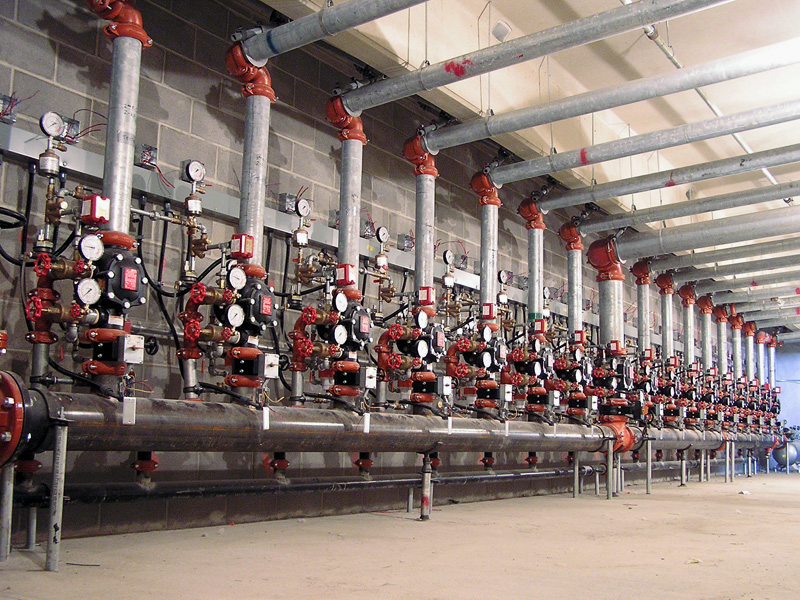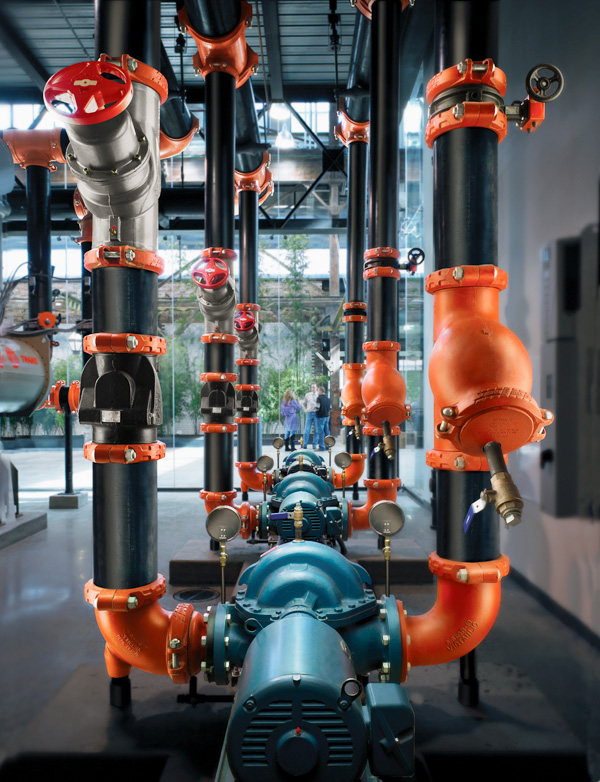Prior to joining Victaulic, Mr. Malloy spent 19 years working for United Technologies Corporation, rising to the position of President for North America for UTC’s Carrier Division. Before joining UTC, Mr. Malloy worked for Air Products & Chemicals and taught economics at Hamilton College. He holds a bachelor’s degree in economics from Boston College and a doctorate in economics from Syracuse University.
In addition to his leadership role at Victaulic, Mr. Malloy shares his talents through active participation on the boards of several well-regarded companies and not-for-profit organizations, including Hubbell Inc., Hollingsworth & Vose, Lehigh Valley Hospital Network and DeSales University.
ISO Focus+ : As one of the world’s leading providers of mechanical pipe-joining systems, how do International Standards contribute to success at Victaulic ?
John F. Malloy : Victaulic is a global organization. We have manufacturing and support centres located in countries throughout the world, including Australia, Belgium, Canada, China, Dubai, India, Mexico, Poland and the United States. Our products are used in countries all over the globe and in markets ranging from oil and gas to mining, power generation, water treatment, marine and commercial building.
The nature of our business and the breadth of markets in which we operate require a global perspective. International Standards are part of the Victaulic difference. As we design and develop solutions, it is important that we adhere to, or even exceed, these standards to support customers worldwide in any industry we serve. It is equally important that we be involved in organizations such as ISO that are helping to propel these industries forward in terms of better quality, safety and protection.
Each country has its own standards and regulations. The complexity of those regulations varies from one country to another, and can also vary from region to region within a country. The harmonization of these individual performance criteria into a single, globally relevant standard can significantly increase our company’s operating efficiency.
 Qualification testing is a key function in determining individual component durability that makes up the overall performance of the end device or complete system. Photo: Courtesy of Victaulic
Qualification testing is a key function in determining individual component durability that makes up the overall performance of the end device or complete system. Photo: Courtesy of Victaulic
As such, it is very important that a company like ours, which continues to expand globally, have direct input into the development of International Standards. By participating in ISO technical committees, we have the opportunity to influence the development or revision of these standards, and introduce the type of technology that a company like Victaulic is employing in its products.
Until those International Standards are fully developed and adopted, we need to be completely knowledgeable about a wide range of local codes and standards, and whether or not our current materials and technology can be incorporated within the scope of these documents. Through the development of International Standards, we gain a better understanding of local practices, laws and regulations, as well as market and cultural considerations.
ISO Focus+ : Regulation and conformity with standards are crucial to ensure the safety, quality and efficiency of products and services. How do standards play a role in regulations ? How do International Standards for conformity assessment benefit the global operations of Victaulic ?
John F. Malloy : Regulations are typically government-mandated legislation, and are enforced by specific agencies that have been granted oversight authority. Regulations often reference relevant standards, where some type of performance or other acceptance criteria may require validation by an independent third-party examiner or testing organization.
The relevant standards provide guiding principles for the qualification of a process, product or system, and incorporate input from a wide range of stakeholders. When ISO standards are harmonized and widely adopted, a manufacturer like Victaulic can shorten the time to market by eliminating redundancies in testing and qualification. We also capitalize on the global consistency the standard affords to our international operations.
I foresee Victaulic becoming more involved with the development of, and participation in, ISO standards because they are looked upon in many countries as the building blocks upon which other standards are developed.
ISO Focus+ : As product testing requires considerable time and money, how can International Standards contribute to increasing efficiency ? Can you give us a few examples ?
John F. Malloy : International Standards contribute to efficiency by harmonizing test requirements. Their intent is to have a single set of criteria that is acceptable to all technical committee members, and yet still meets the local code or laws of the country or jurisdiction they represent.
A manufacturer benefits greatly when they can economically produce a single product or component that complies with an International Standard adopted and used by a wide range of supporting countries. The technical committee developing the standard strives to reach consensus as to the specific tests that should be included, and what is most sensible for the global market. Global relevance is key to ensuring that products can pass all applicable tests, be sold and distributed around the world, and function properly in all applications.
At Victaulic, a key portion of our business is the design and development of fire protection systems components, including sprinklers, couplings, fittings, valves, alarm devices, accessories and pipe preparation tools. Our Director of Global Regulatory Compliance, Len Swantek, chairs ISO technical committee ISO/TC 21, Equipment for fire protection and fire fighting, subcommittee SC 5, Fixed firefighting systems using water. The committee takes input from global manufacturers, testing authorities, installers, fire code enforcement officials and others. These organizations bring their unique perspective to the committee on how they test products and view the advancement of the global fire safety industry.
ISO Focus+ : Since its establishment in 1925, Victaulic has prided itself on innovation. What in your view is the contribution of International Standards to innovation ? Is there a right moment for the development of standards for new technologies ?
John F. Malloy : ISO, through its standards development process, seeks to promote innovation. As members of ISO technical committees (TC), we are encouraged to introduce and share technology or new materials. There is a certain level of “ cross-training ” during committee sessions that provides a new understanding for those delegates who may not have the same level of expertise or market experience in their home region.
Because of the need to ensure harmonization, consensus building and global relevance, the introduction of new technologies must be timed appropriately. This can be critical to those manufacturers who may have patent concerns, or may not have sufficient field history to support the introduction of such technologies on a global scale. However, many companies with proven expertise and statistical data to back up their work often take the lead in introducing new materials, technology or scientific breakthroughs.
ISO Focus+ : What are the benefits of getting involved in international standardization ? Can you tell us about some of the areas in which Victaulic participates ?
John F. Malloy : As I previously mentioned, Victaulic is active on ISO technical committee ISO/TC 21/SC 5. Through our participation on SC 5 and, more directly, on the US Technical Advisory Group (USTAG), we play a role in shaping fire safety standards that affect the most critical components and qualification methods. Ultimately, our contribution − like that of others − hopefully improves the quality and reliability of fire protection products and life safety systems in general.
There are also a number of intangible benefits. Interacting with delegates from countries all over the world provides a well-rounded and balanced perspective. You learn of their challenges and the solutions they employ. We share knowledge, cultural experiences, and numerous unique perspectives and, in many cases, it sparks great friendships. At the end of the day, the technical committee members are all trying to save lives, protect property, and minimize risk. You quickly realize that you are all there for the common good.
 Victaulic openly collaborates on system design and product applications to the benefit of other ISO TC delegates who may have less technical expertise in their home region. Photo: Courtesy of Victaulic.
Victaulic openly collaborates on system design and product applications to the benefit of other ISO TC delegates who may have less technical expertise in their home region. Photo: Courtesy of Victaulic.
ISO Focus+ : What is the value of management system standards like ISO 9001 ?
John F. Malloy : Our quality management system (QMS) certification, which we achieved in the late 1980s, has become a key element in our overall regulatory operations.
Originally, certification to ISO 9001 was viewed as an important part of our European sales portfolio. However, in more recent times, this certification has become an invaluable asset in terms of how our operations are viewed by the many regulatory auditing bodies.
We have found that having a quality management system certified to ISO 9001 provides other external auditing bodies with a well-organized structure to follow in their own auditing process. This reduces auditing time and enables a multitude of regulators to quickly check those key elements that have the greatest impact on product and process control.
Additionally, the ISO 9001 certification is widely recognized by testing organizations and labs, and the process we went through to achieve this, gives them an added level of assurance. Achieving and maintaining certification to ISO 9001 is not an easy task, but it certainly lends credibility to an organization like Victaulic, which manufactures and distributes its products worldwide.
In addition to our QMS certification, we have taken steps to ensure that we control the quality of every component of our products. At Victaulic, we are vertically integrated in our manufacturing processes to ensure maximum quality control from the development phase through to the commercialization of our solutions.

About Victaulic
The grooved piping method – which dramatically reduces the amount of installation time and reduces total installed costs compared to welding, threading and flanging – is now the predominant global method for the assembly of heating, ventilation and air conditioning (HVAC), plumbing and fire protection piping systems. In addition to commercial buildings, Victaulic products are used in utility and process piping applications in some of the world’s most demanding markets, including oil, gas and chemical, mining, power generation, water and wastewater treatment , and military and marine systems.
Headquartered in Easton, Pennsylvania, USA, Victaulic has manufacturing and distribution facilities worldwide and employs approximately 4 000 people. For more information, visit www.victaulic.com.


